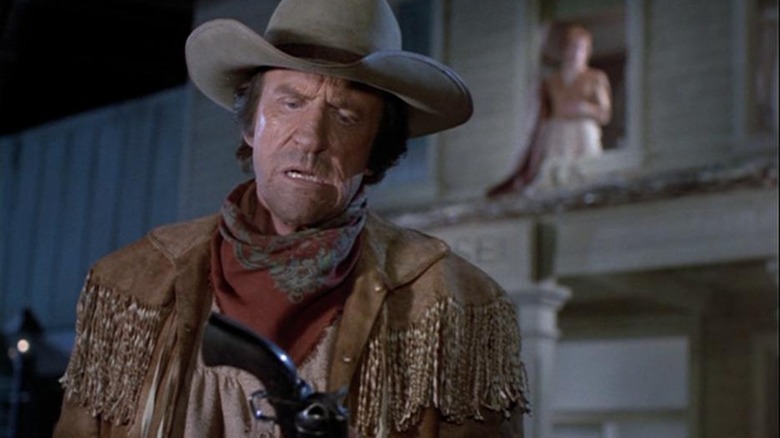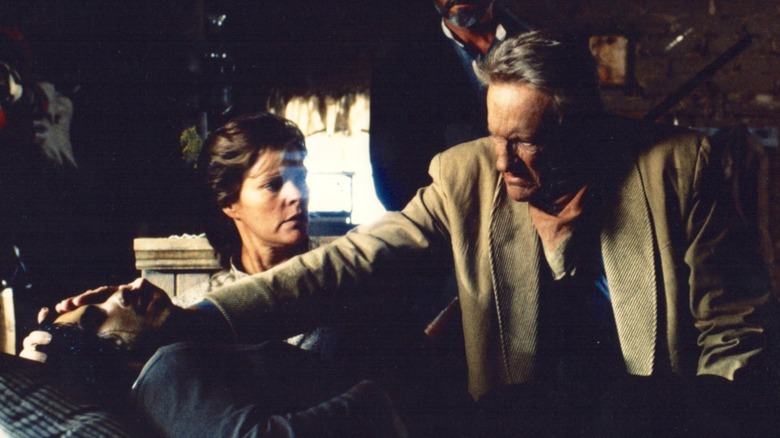Norman Macdonell and John Meston’s “Gunsmoke” drama series aired on CBS for 20 uninterrupted seasons (!), a feat that seems even more impressive because of the consistent quality it maintained throughout its run. Initially a radio series that aired between 1952 and 1961, “Gunsmoke” gained enough popularity to warrant a television adaptation in 1955, whose half-hour episodes create an epic Western saga for the ages. “Gunsmoke” concerns Marshal Matt Dillon (James Arness), a lawman tasked with maintaining order in Dodge City, Kansas, and his exploits underscore the brutality of the Old West, challenging the stereotypes associated with similar characters molded as apparently heroic. Though the serial employs archetypal characters — such as loyal sidekick Chester Good (Dennis Weaver) and trustworthy town physician Doc Adams (Milburn Stone) — a fair amount of subtlety grounds “Gunsmoke,” which works best when rooted in morally gray storylines.
However, we’re not here today to talk about the merits of the CBS series, but rather to explore the viewing order for the five television movies released after the show’s long run ended. The first “Gunsmoke” movie was commissioned by CBS in 1987 as a reunion project and saw Arness and longtime cast member Amanda Blake (who played Kitty Russell) return to their roles, with most of the supporting cast also returning. Although the release order of the five made-for-TV “Gunsmoke” movies isn’t difficult to follow, referencing the chronology of events can be challenging, as some of the plot lines are based on episodes from the primary series. Without further ado, let’s dive into the harsh, uncompromising world of “Gunsmoke,” where chaos lurks around every corner in Dodge City and beyond.
The Only Right Way to Watch the Gunsmoke Movies
To fully understand 1987’s “Gunsmoke: Return to Dodge,” it’s important to have a rough idea of how the original series ended and why this reunion TV movie is being hyped so much. The return of most of the main cast, especially Arness and Blake, forms the emotional core of this particular entry, as well as allowing the iconic Matt Dillion to keep wielding his gun after retirement. In “Return to Dodge,” Dillon is a fur trapper who is stabbed along the river, and is carried to, you guessed it, Dodge City by the men who found him wounded. After recovering, Dillon reunites with Miss Kitty, but this joyous homecoming is spoiled when gunman Will Mannon (Steve Forrest) is released from prison. Of course, the marshal is Mannon’s main target for revenge, and the two engage in a prolonged game of cat-and-mouse for the rest of the season, with the confrontation ending in brutal fashion.
After watching “Return to Dodge,” it’s time to move on to 1990’s “Gunsmoke: The Last Apache,” which revisits the episode “Matt’s Love Story.” Instead of being set in Dodge, the story shifts to Arizona and Mexico, where Dillon receives a letter from the Yardner Cattle Company, a reference to the widowed rancher in Season 19, Episode 3 (originally played by Michael Learned, who reprises his role in the film). A trip to the Arizona ranch leads to plenty of mischief, as news of the escape of Apache Chief Geronimo (Joaquin Martinez) twists events, with War Chief Wolf (Joe Lara) presenting a formidable threat. Dillon also grapples with emotional revelations that alter the trajectory of his survival, raising high personal stakes in this thrilling adventure.
Why do the Gunsmoke films feel so special?
Even though the “Gunsmoke” series lasted a full 20 seasons, the cast and crew were eager to continue this epic western, and the news of the show’s cancellation (which was entirely CBS’s decision) stunned them at the time. 1992’s “Gunsmoke: To the Last Man” continues the epic story of Dillion – now a rancher – becoming embroiled in a family feud that turns much worse when the Grahams kidnap his daughter Beth (Amy Stoch). There’s somewhat of a rewriting of canon, as the memory of Kitty seems like a distant dream alongside Dillon’s relationship with Beth (and her late mother, Mike), whose presence in Pleasant Valley acts like a moral compass for Dillon amid the war.
Lastly, but most importantly, finish up your “Gunsmoke” marathon with 1993’s “Gunsmoke: The Long Ride” and 1994’s “Gunsmoke: One Man’s Justice.” “The Long Ride” starts off on a happy note as Beth is getting married and everyone is busy celebrating, but something happens unexpectedly. Very Wrong: Poor Dillon is accused of murder and has a hefty bounty on his head. With no choice but to go on the run, Dillon sets out to catch the real culprit and clear his name in the process, while Beth helps her dad deal with messy gang dynamics and the inevitable saloon shootout.
“One Man’s Justice” is the final stop at the “Gunsmoke” station, with Arness impersonating Dillon one last time. This time, a stagecoach robbery leaves three victims injured, including Dillon’s son-in-law, and the retired marshal offers them all shelter out of goodwill. However, an unfortunate death leads to a grieving son’s weak plan for revenge, prompting Dillon to step in and shoot some bad guys one last time (with a mysterious partner) before he can live a peaceful life forever.














